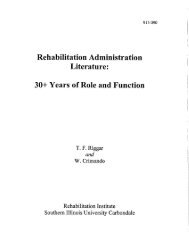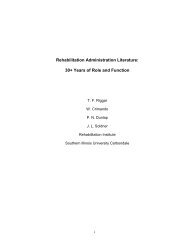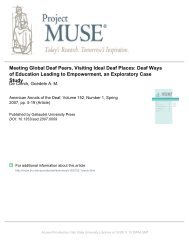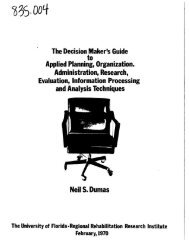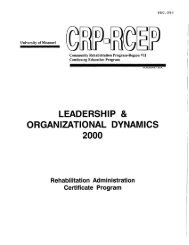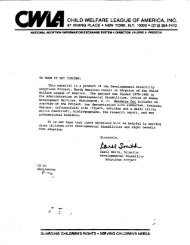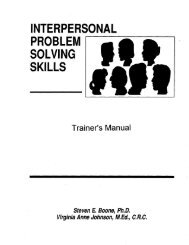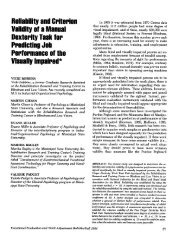by requirements for the degree of (Education) - NCRTM
by requirements for the degree of (Education) - NCRTM
by requirements for the degree of (Education) - NCRTM
Create successful ePaper yourself
Turn your PDF publications into a flip-book with our unique Google optimized e-Paper software.
vocational schools, and vocational rehabilitation .agencies all have a<br />
responsibility to provide <strong>for</strong> <strong>the</strong> education and training <strong>of</strong> older mentally<br />
retarded students. The statutes do not place sole responsibility on any<br />
one <strong>of</strong> <strong>the</strong>se agencies; <strong>the</strong>re<strong>for</strong>e, <strong>the</strong> inference is that it is <strong>the</strong> mutual<br />
responsibility <strong>of</strong> all. Within <strong>the</strong> public school structure <strong>the</strong> junior and<br />
senior levels <strong>of</strong> high school have a responsibility <strong>for</strong> providing a modified<br />
or "special" Program <strong>for</strong> <strong>the</strong> educable adolescents possessing sufficient<br />
intellectual ability, social maturity and motivation to strive <strong>for</strong> social<br />
and economic competence in accordance with his or her abilities. For <strong>the</strong><br />
trainable student whose level <strong>of</strong> intelligence and adaptive behavior are<br />
too low to benefit from a high school special education Program, separate<br />
curricula and facilities are provided (Wisconsin Department <strong>of</strong> Public<br />
Instruction, 1967).<br />
State laws have been passed which support local communities in <strong>the</strong>ir<br />
ef<strong>for</strong>ts to provide special education services. The first legislative<br />
provision <strong>for</strong> state support <strong>of</strong> special classes <strong>for</strong> <strong>the</strong> mentally retarded<br />
was made in 1917. Since that time, expanded aids and reimbursements have<br />
been legislated to encourage <strong>the</strong> establishment and expansion <strong>of</strong> special<br />
classes and services. In 1939 <strong>the</strong> Bureau <strong>for</strong> Handicapped Children was<br />
organized as part <strong>of</strong> <strong>the</strong> State Department <strong>of</strong> Public Instruction to inte-<br />
grate all areas <strong>of</strong> services <strong>for</strong> handicapped children into one •agency. Then<br />
in 1968 under <strong>the</strong> Kellett reorganization <strong>of</strong> state agencies it became <strong>the</strong><br />
Division <strong>for</strong> Handicapped Children's Services. General areas <strong>of</strong> responsi-<br />
bility include: a) leadership and consultation, b) planning c) research<br />
and evaluation, d) coordination, e) certification, f) public relations,<br />
g) aids and reimbursements [Wisconsin Department <strong>of</strong> Public Instruction,<br />
no<br />
date).




